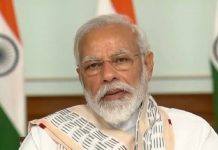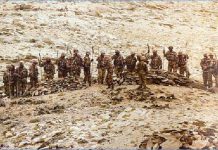“…Something has gone drastically wrong. [The CRPF men] seem to have walked into a trap set by the Naxalites.” — Home Minister P Chidambaram, on the Maoists’ killing of 75 paramilitary men and a policeman in Chhattisgarh on April 6

IT LITERALLY is the dead of the night. “Bastards,” spits the lowly officer, his vest soaked with sweat, the surgical mask now lowered to his chin, tired eyes bloodshot with rage, the furious voice a whisper, for who wants to talk around sixty-one coffins being filled with dead men so many of who you knew by nicknames? Laced with chemicals, wrapped as mummies, the bodies brought from their mass autopsy are lowered into the plywood caskets that were banged together all evening. Silent young men nail the lids shut and load them onto trucks.
Surprisingly, or perhaps not, the officer’s vitriol is flung not at the Maoists who had hours earlier inflicted the biggest casualty on the uniformed men in their four-decade-long insurgency. Instead, the officer is beyond mad with the government “because it knows nothing here and will get us all killed”. What he doesn’t say, because he doesn’t know, is that the government doesn’t care either.
You would imagine a government that proclaims the slain men as martyrs and tops their coffins with the Indian tricolor for Chidambaram’s photo-op a few hours later would be moved to a nightlong wake for the dead; that its politicians and officers — both uniformed and civilian — would lead from the front to recoup from this terrible tragedy and rebuild the morale of their foot soldiers; that, grieving and in solidarity, they would swarm the makeshift mortuary, that at least some would go sit beside the hospital beds of three heroic survivors.
After all, the dead gave their lives so that, to borrow from Chidambaram’s rhetoric, “the writ of the State” could run in the forests of Chhattisgarh. But at 2 am on April 7, hours before Chidambaram’s farewell to the dead and barely 18 hours after the CRPF combatants were gunned down, it is only the angry lowly officer, a sub-inspector, representing the State at this government hospital at Jagdalpur town, 150 km north of the site of the deadly Maoist attack. It must be said that he is here on his own and not detailed for the job.
No chief minister, no state home minister, no other minister, no member of Parliament, no MLA, no director-general of police (Vishwa Ranjan, a man popular with journalists in all seasons), no chief secretary, no home secretary, no inspector-general (TJ Longkumer, who Chidambaram later told journalists had planned the dead men’s fatal foray into the forests), no district magistrate (frenzied a few hours later as reporters surged at Chidambaram’s press conference because he didn’t want anyone to throw a shoe at the Union home minister), no superintendent of police, not one high-ranking officer of the Central Reserve Police Force (CRPF), to which 75 of the dead belonged, were here; just the very angry CRPF sub-inspector. “They were like my children,” he says.
Typically, the survivors mattered less than the dead. Head Constable Raj Bahadur and Constables Pramod Kumar Singh and Baljeet Singh are lucky to survive the carnage, having taken bullets everywhere but in the guts. A hundred paces from the mortuary, they lie writhing in pain on dirty hospital linen stained from previous occupants’ dried blood. Only one has a mosquito net. There are no doctors or nurses. Two constables who’ve come on their own watch over their wounded mates. The ward is a hovel; the toilet is a stinking blocked drain. “Our officers are home sleeping,” an attendant says.
[cycloneslider id=”shahid”]
Five hours later, just minutes before Chidambaram and Chhattisgarh Chief Minister Raman Singh visit the heroes, bureaucrats and the hospital’s administrators fuss in panic over the non-functioning air-conditioning. “Can’t it run for just 15 minutes?” asks one. Bottles of intravenous fluids now hang from their stands, their needles pushed into the arms of the wounded. These weren’t here six hours earlier. The linen has changed. The hovel is now spic and span. A couple hours later, Chidambaram chokes at a press conference, grieving the dead and expressing his resolve to wipe out the Maoists.
DRASTICALLY WRONG
Perhaps bigger than the tragedy that befell the men who died in the Maoist attack is the tragedy of Chidambaram beginning to fall for his own rhetoric. This is the classic case of the emperor that had no clothes but none would tell him the naked truth. Tuesday’s horrific killings should jolt Chidambaram and his government into realising that rhetoric is not the reality, that his paramilitary men are sitting ducks for the Maoists just about anywhere, anytime. Instead, he continues to claim that the security forces would wipe out the Maoists in three years.
“We salute the brave jawans who have laid down their lives in the defence of freedom, liberty and democracy,” a solemn Chidambaram said at the press conference, reading from a text. Then the rhetoric and the hubris surged: “Let us not forget that the goal of the Naxalites is to overthrow the established authority of the government through armed liberation struggle. We cannot, and we shall not, allow them to succeed in that goal… The State has a legitimate right to deploy its security forces to resist, apprehend and, if necessary, neutralise militants who are determined to strike at the very roots of our nation.”
Chidambaram also claimed that a fuller account of what happened during the April 6 attack on the CRPF patrol would emerge from the “debriefing of the injured jawans”, which might happen at a later stage. This reporter already spoke at length with the wounded CRPF men at the hospital on the night of the attack, hours before Chidambaram visited them. Their accounts are a shocking testimony to an utter lack of preparedness to meet the Maoists.
To begin with, at least 48 of the 82 men in the ill-fated CRPF patrol that the Maoists fired upon had zero knowledge about the area they had been patrolling for one day and two nights before the fateful morning. These 48 men belonged to the Alpha Company of the CRPF, which had transferred to the local camp of the paramilitary at a location named Chintalnar only a week before the attack.
That these personnel, unfamiliar with the nearby forests the Maoists heavily dominate, were sent out for a three-day “area domination exercise” can only be described as a suicide mission. “When the firing began,” says Constable Pramod Kumar Singh, 28, “we had no chance.” Pramod and Head Constable Raj Bahadur, both from Alpha Company, did not know east from west at the site. “The Maoists were everywhere,” says Bahadur. “On the hill on the left and on the hill on the right, on the trees, and behind us. Everywhere.”
18 hours after the CRPF combatants were gunned down, only an angry, lowly sub-inspector represents the state at the makeshift mortuary
In fact, the patrol’s journey over the two nights was a virtual advertisement of their itinerary. The 82-man party had left its camp at Chintalnar on the evening of April 4 and headed for a village 12 km away for a “search operation”. That is CRPF-speak for banging doors in a village and rounding up folks there for grilling and sometimes worse. By 11 pm, it had retreated close to its camp and halted the night outside another village.
The party slept around midnight and was up at 2 am, and had left in another hour. The next day, too, was spent in “search” across several villages. The night of April 5, it halted outside another village, sleeping again in the open after the community cooking and dining. Once again, it was up at 2 am and had begun its march an hour later. Around 5.30 am, the Maoists attacked it. It is stunning that the CRPF war room strategists failed to realise that they were making the men vulnerable to Maoist attacks by making them stay out two consecutive nights in a location most men in the patrol did not know.
WALKING INTO A TRAP
Indeed, two things emerged from conversations with CRPF personnel at Jagdalpur. One, such “area domination exercises” cannot possibly be run for three days without a very high risk of being attacked. And two, it is absurd to have only 80-odd men in a three-day patrol that’s entirely on its own, away from the camp. “There should have been at least 500 men in that party,” said a CRPF constable of the Alpha Company who was not in the party attacked upon on Tuesday but had been involved in an offensive last September. “This team was outnumbered by at least one to five.”
Of course, what is even more embarrassing for the government is that the Maoists attacked barely 4 km from the CRPF camp in south Dantewada district. In fact, this is an area where a 50-km stretch has four CRPF camps as well as numerous government-run refugee camps to which tens of thousands of the tribal people have been forcibly brought since 2005 by the controversial governmentbacked Salwa Judum militia that is drawn from among the tribal people.
Given that the vast southern region of Chhattisgarh where the Maoists have a free run is bigger than Kerala, just what does the State control if the Maoists finish off an entire patrol 4 km from a full-fledged CRPF camp? (In fact, the attack site is only a kilometre from a path much traversed by the CRPF.) Three hours into the Maoist attack, a rescue vehicle — a modified Tata 407 known as ‘bunker’ that is supposedly bombproof — started from the camp to evacuate the holed-out personnel. The Maoists blasted an IED through it, killing its driver — just 2 km from the camp. Chidambaram acknowledged that the Maoists fired at and stopped rescue parties from reaching the location.
Survivors remember maoists roaming among the fallen men. The rebels took away their weapons and wireless sets
Chillingly, the survivors remember the Maoists roaming among the fallen men after the shooting ended, possibly four hours later. “I heard men, women and even children,” says Raj Bahadur. “I kept my head down and pretended to be dead.” Every man in the CRPF patrol had held a weapon. These included about 60 INSAS rifles, 10 AK-47 assault rifles, 10 SLRs, four SLRs with improvised grenadelaunchers, 40 bombs and four mortar guns. The patrol also had 15 wireless sets. The Maoists took away everything. The rescue parties, including from the Chintalnar camp, began arriving much later.
CANNON FODDER
It is common knowledge that the rebels know the forests like the back of their palms because they were born here, that they most possibly have the backing of an overwhelming majority of the hundreds of thousands of the tribal people living across more than 20,000 sq km. On the other hand, the few thousand CRPF men here hail from all over India, and have lived here only months, if that.
Of the 61 coffins laid out for Chidambaram’s send-off (15 other bodies, brought to Jagdalpur on April 7, could not be autopsied before his arrival), 31 men belonged to Uttar Pradesh. Others came afar, from Assam to Kerala. Two officers who perished in the assault — Deputy Commandant Satyavan Singh and Assistant Commandant Bajrang Lal Meena (who headed the Alpha Company) — were from Jhunjhunu in Rajasthan. The forests were never theirs. Only two coffins bore names native to Chhattisgarh.
In any case, it is not as if the slain men had been trained in jungle warfare specifically for Chhattisgarh. Surviving Constable Baljeet Singh, 26, who joined the CRPF in 2007 and was among the few men from the Charlie Company in the fated patrol, says he was trained in the forests near Jalandhar in Punjab, and only a month there. The forests of Chhattisgarh, he admits, are way thicker and trickier. The training in Punjab was in “how to load and fire the guns, to take positions under attack”. Why wasn’t this training specific to tackling the Maoists? He thinks and says: “I guess guerilla tactics are the same everywhere, from Kashmir to Chhattisgarh.” After a pause, he adds: “I am only a constable.”
Survivors say they knew the patrol had a slim chance when maoists attacked. They fought as long as they could
Even Raj Bahadur, who at 48 years is a 22- year CRPF veteran and seen action from Kashmir to Tripura, has never witnessed anything like Chhattisgarh. “This was the worst I was ever in,” he says. It is incredible that the three survivors have never met a surrendered or captured Maoist.
One would imagine that the many captured Maoists, ranging from ideologues such as Kobad Ghandy arrested in New Delhi to the armed insurgents nabbed in the forests, would have proved a goldmine of information for the planners of the security forces’ counter-offensive. But the three survivors — who are the most crucial foot soldiers the paramilitary has — cannot recall attending any briefing from the CRPF planners to share Maoist warfare strategies with them. If anything, these men said that constables such as themselves (who numbered around 60 of 82 on Tuesday) are routinely told nothing but “only to go out and search” and, if need be, “shoot”.
It is difficult to put down such obstinacy to anything but the hubris of the officers. In September 2009, a posse of the elite COBRA force struck deep in the Maoist territory and destroyed a factory manufacturing guns locally called bharmar. A surrendered Maoist, a woman, had accompanied and guided that team to the site. The deed done, the woman urged the COBRA team to leave immediately. But they ignored her warning. That proved to be a fatal mistake, as the next morning, the Maoists laid a siege to the entire area.
A CRPF team led by Deputy Commandant Meena — who died in Tuesday’s attack — had to rush to evacuate the COBRA combatants, but not before the Maoists killed six, including two assistant commandants. “The Maoists walked parallel to us at some distance for 6 km, firing continuously at us as we carried the dead on our shoulders,” says one CRPF constable, who participated in the rescue. “I fired two mortars so that the helicopter with the injured could fly.” He fired two more after the helicopter took off, just in case.
In Tuesday’s attack, too, the CRPF survivors say they knew right at the start of the attack that the team had a slim chance of surviving. “We survived because we were too far at the back,” Raj Bahadur says. The survivors held out, firing their guns as long as they could before piercing bullets rendered them unconscious. Deputy Commandant Satyavan Singh, the patrol’s leader, and Assistant Commandant Meena were possibly among the last dozen to be alive. “Meena asked me to take care of myself,” Pramod remembers. “That’s the last I saw of him.”
As Chidambaram left, so did the doctors and the officers at the ward. On Thursday, the three survivors were restless to leave the hospital. Raj Bahadur hopes that any compensation that may come his way will help pay off the Rs 1.5 lakh of the debt he still owes back in Agra for his daughter’s wedding four years ago, which his meagre take-home pay of Rs 18,000 has failed to pay off. Pramod is worried sick because his father in Aligarh has cancer and has lost all his hair to chemotherapy.
Baljeet just wants to go home in Haryana’s Sonepat to his new bride he married on February 16. He spent only 23 days with her before coming back to Chhattisgarh. If he gets leave, he would get only some weeks with her before returning to the forests for months of separation — a pattern that would recur throughout the years he will spend defending freedom, liberty and democracy.
WRITER’S EMAIL
ajit@tehelka.com











